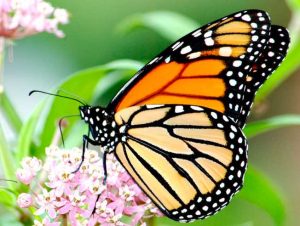By Dave Lindorff

I found them today: five plump zebra-striped caterpillars munching with gusto on milkweed leaves in an area of the tall dark-leaved plants growing in my front yard.
The beautiful orange-and-black monarch butterfly that I saw a few weeks ago flitting from plant to plant in that milkweed patch I have nurtured and allowed to expand naturally in my front yard over the last few years, apparently deposited an egg on each plant it landed on, and these ultimately hatched out a batch of voracious little larvae this year for the first time.
In a time when the evidence of the damage caused by mankind’s profit-driven environmental depredations — especially climate change — is become truly damning and deeply depressing, it’s a spirit-lifting bright spot for me to see the success of this one small effort to aid one beautiful and remarkable insect in its desperate struggle to survive.
The monarch, truly one of the most beautiful creatures on earth, has an almost unbelievable life cycle. Born in late summer, it has for millennia flown by the millions from the temperate part of North American continent in the US and Canada all the way down to Mexico — or if they are on the west coast, to California. Those who make the journey successfully to Mexico gather in a relatively small tree-covered forest region, choosing the oramel pine as their resting place. After over-wintering, they begin a migration back towards their summer habitat in the north.
No single monarch makes this epic round-trip migration, though. Rather, the delicate insects mate and lay eggs along the way and die, with their offspring beginning the return journey the following spring. They too don’t make it all the way north either, but mate and lay eggs en route, with their offspring continuing the journey north. Finally these undocumented immigrants flooding across the border from Mexico mate and their offspring are the ones I saw laying eggs on my milkweed plants, and whose offspring in turn are now munching away preparing for their short time in the chrysalis stage before becoming butterflies and beginning their own journey south.
Years ago, when I was a kid living in Connecticut, late August and early September were the time that fields, which were full of milkweed back them in the era before Monsanto’s ubiquitous Roundup, were also full of monarchs and their caterpillars. Almost every year, I’d go out and find a caterpillar or two, with their black and yellow stripes on a white background. I would put my find in a jar or aquarium filled with milkweed leaves.Then I’d watch them eat, grow and become a chrysalis, and finally, in a spectacular metamorphosis, crack out of the jewel-like jade-colored encasing chitin to hang from a branch and allow crumpled wings to fill out with blood and dry — an amazing sight!…
For the rest of this article by DAVE LINDORFF in ThisCantBeHappening!, the uncompromised, collectively run, six-time Project Censored Award-winning online alternative news site, please go to: www.thiscantbehappening.net/node/3947

